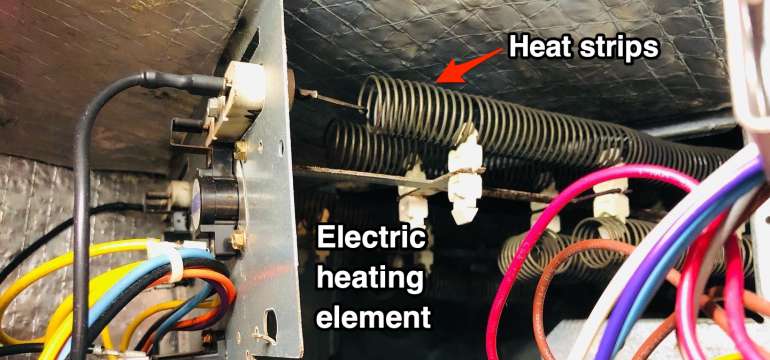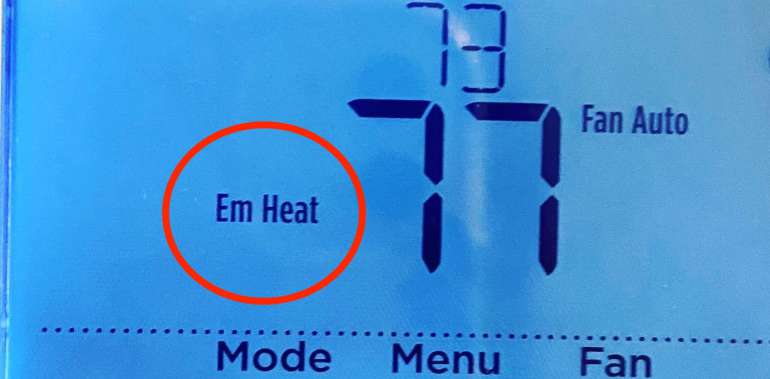Auxiliary heat is a backup source of heat for your HVAC system. It’s usually labeled “AUX” on your thermostat.
When your HVAC system’s heat pump can’t warm your home adequately, AUX heat kicks on to get the job done.
Your auxiliary heat shouldn’t stay on for very long because it requires a lot of energy to work. If your AUX heat is constantly running, you should call an HVAC professional to look at your system.
In this article, we’ll explore the ins and outs of auxiliary heating. By the end of it, you should know exactly how this function works in your home.
What is auxiliary heat on a thermostat?
As just stated, it’s basically a supplement heat source to your heat pump. Auxiliary heating keeps your home warm when your heat pump isn’t able to do so on its own. It remains on until your house has been heated up to the desired temperature.
AUX heat automatically turns on after your heat pump hasn’t reached the desired temperature for a set amount of time. This could be any amount of time between 5 and 20 minutes.
Most thermostats have pre-programmed AUX heat settings. These turn on automatically when certain conditions are met.
How AUX heat works
Heat pumps work through a process called heat transfer. Your heat pump brings in heat energy from outside through its refrigerant lines. Then it distributes throughout your home to warm your house.
A heat pump is considered a “first-stage” heating solution. That’s because it’s the primary source of heat for your home. AUX heat only turns on when a heat pump isn’t warming your home fast enough.
The power source behind auxiliary heating depends on the nature of your HVAC system. But it often comes from heat strips. This is made up of wire heating elements that warm up with electricity. It’s a more power-intensive form of heat designed to provide fast heating results.
 Most systems also have supplemental heating. As well as electric resistance heating, these are things like:
Most systems also have supplemental heating. As well as electric resistance heating, these are things like:
- Gas backups
- Oil backups
- Hot-water backup systems
Heat pump vs. AUX heat
- Heat pumps absorb heat energy from outside your home. AUX heat uses warm air from the interior of your home.
- Auxiliary heat components are located inside your home. But most heat pumps are located outside of the home.
- Auxiliary heat is only designed to be used in limited circumstances. It’s 50% more expensive than using a heat pump, so it should never be a primary source of heat.
When AUX heat should turn on?
Auxiliary heating should only turn on in certain situations. We’ll cover the three most common below. If you find your AUX heat turning on outside of these situations consistently, your HVAC system likely needs repairs or maintenance.
☆ The temperature outside is below 35 degrees Fahrenheit
Heat pumps work by pulling warm air from outside into your home. When temperatures drop below 35, there isn’t enough warm air for them to work efficiently.
When this happens, your auxiliary heat will come on. It will stay on until either your home reaches the desired temperature or outdoor temperatures warm up.
☆ You’re trying to increase the temperature by more than 3 degrees
It can take some time for a heat pump to increase the temperature in your home. When you ask a heat pump to add more than 3 degrees to your internal temperature, AUX heat comes on.
That’s because your thermostat wants to make sure your home warms up in a timely manner. It uses AUX heat to make that happen when you want the temperature to go up by more than 3 degrees.
☆ Your heat pump is in defrost mode
Defrost mode turns on when your heat pump gets covered in ice. This mode thaws the ice so that the heat pump can get back to its normal functioning.
Auxiliary heat comes on while this happens because your heat pump needs to defrost before it can resume warming your home. AUX heat should turn off once defrost mode is completed.
If you’re not sure whether your HVAC system is in defrost mode, here are some common signs to look for:
- Steam or water appearing on the outdoor part of the unit
- The outdoor fan stops running
- Your thermostat displays a blinking light
It’s usually not possible to change the AUX heat trigger point
You may not want your auxiliary heat to turn on as often as it does. But unfortunately, most thermostats won’t let you change the AUX heat trigger point.
A professional may be able to modify your system to make this happen. But it’s not an easy job.
If you don’t want your AUX heat to turn on as much, focus on keeping your home warm. You can do that by adding more insulation to it and being more consistent about HVAC maintenance.
How long AUX heat should run?
Auxiliary heat should only be on until your home reaches the desired temperature.
For example, let’s say it’s 67 degrees in your home, and you set your thermostat to 71. Auxiliary heat should turn off as soon as the thermostat hits 71 degrees.
This shouldn’t take much longer than 30 minutes—if even that long. So if your AUX heat is on for longer than that, your system likely has a problem.
According to the American Society of Heating, Refrigerating, and Air-Conditioning Engineers (ASHRAE), parts of New York experience temperatures below 15 degrees Fahrenheit between 1.5 and 5% of the year.
This amounts to about 130 – 450 total hours each year. Your AUX heat may turn on during this time. But it should only do so for short amounts of time.
Why your auxiliary heat could be staying on?
If your auxiliary heat is staying on, it’s because your heat pump isn’t working as it should be. That could be happening because:
- You need to replace some HVAC parts
- Your air filters are dirty
- You’re running out of refrigerant
Regardless, if you notice AUX heat staying on, you need a professional’s help to find the problem and solve it. If you want to read more, we have an article on what causes the auxiliary heat to stay on.
Here’s why you shouldn’t overuse AUX heat
Using auxiliary heat too often can drastically increase your energy bill. That’s because this function isn’t as energy efficient as heat pumps are.
Additionally, if your AUX heat turns on too often, it could wear down faster. That means you might have to pay for costly repairs faster than you should.
Taking proper care of your auxiliary heat pump
You can expand the lifespan of your auxiliary heat pump by taking proper care of it. We’ll cover the best strategies for doing that in this section.
- Start by having your HVAC system inspected and maintained regularly. This should happen about once every six months.
- Additionally, make sure to clean your air filters regularly. Dirty air filters are one of the most common reasons for an HVAC system to be inefficient. Experts recommend cleaning these once every 1-3 months.
- Next, only use emergency heat when absolutely necessary. If you use it too often, you’ll put a ton of unnecessary stress on your system. And your energy bill will sky-rocket.
- Lastly, fix HVAC problems as soon as you find them and follow the instructions in your owner’s manual. Doing these things will help to make sure you get as much out of your system as possible.
Why is my auxiliary heat not working?
Your auxiliary heat may stop working from time to time. The most common culprit behind this problem is a dirty filter. So cleaning yours should usually be the first fix you try.
But you might still have problems even after cleaning your air filters. If so, you may need to replace a heating element, or you could have a burned-out motor. Either way, calling a professional will be the solution.
Some thermostats have emergency heat instead of auxiliary heat

It’s worth noting that some thermostats have a feature called emergency heat in place of AUX heat. And some systems will have both of these functions.
- Many people use the two terms interchangeably. They do so because both emergency heat and auxiliary heat are backup sources of HVAC warmth.
- Emergency heat doesn’t use your heat pump functionality. Instead, it relies on your system’s secondary source of heat (such as electrical resistance heating).
- If your system has both functions, refer to your owner’s manual. It will tell you the specific ways that they differ from one another in your HVAC system.
- When your emergency heat light turns on, look to see if the thermostat is set to Emergency Heat. If it’s not, you have a problem with your heat pump and should call a service professional.
- What to Do if Your House Smells Like Gas but There’s No Leak - February 6, 2023
- Why Is There a Burning Smell Coming From My Vents? - August 16, 2022
- How to Remove the Musty Smell From Your Air Conditioner - August 16, 2022


Paul
Wednesday 19th of April 2023
My Fujitsu heat pump has electric auxiliary heat, but there is no way for me to know when the auxiliary heat is on. The term 'auxiliary' is not in the thermostat menu; there is no light indicator etc. Can I just turn off the separate heat element breaker at the panel?
PS I live in the relatively mild Pacific Northwest, and I have a 'cold climate' heat pump; it should be able to heat my home without auxiliary heat. Thanks
Michael Joseph
Wednesday 19th of April 2023
You should check if your thermostat has a W2 wire. You can easily disable the auxiliary heat by disconnecting the wire from the “W2” terminal.
Also, you can change your thermostat to a model that you can disable the auxiliary heat entirely.
Vicki
Wednesday 14th of November 2018
When my heat pump turns on the temperature drops about 4 degrees before it starts to warm up.